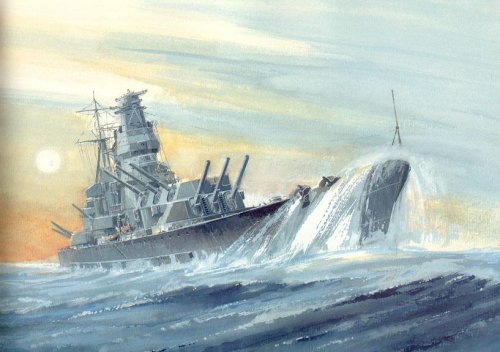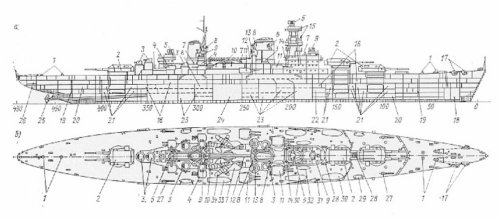The Kronshtadt class (Project 69) were a class of battlecruisers ordered for the Soviet Navy in the late 1930s. In the Soviet Union they were called "heavy cruisers" or thyazholyi kreyser.
Two ships were started, but none were completed due to World War II. These ships had a complex and prolonged design process which was hampered by the imprisonment of most of the design team due to Stalin's Purges. Germany sold the Soviet Union six surplus twin 15-inch (380 mm) gun turrets, similar to those used in the Bismarck-class battleships. Rearming these ships with the German weapons was considered, known as Project 69I, but no turrets were actually delivered.
Only one hull of the pre-war Kronshtadt class survived the conflict intact and was about 10% complete in 1945. She was judged obsolete and a new design was begun to take war experience and new technology into account. The new design was ordered as the Project 82 Stalingrad-class battlecruiser but was also never completed.
Ships of the Class
Kronshtadt - built by Baltic Shipyard Leningrad - laid down 15 July 1939 - Scrapped 1948
Sevastopol - built by Marti Yard, Nikolaev - laid down 1939 - incomplete hull captured by the Germans in 1941 and scrapped
General Characteristics
Type: Battlecruiser
Displacement: 35,240 tons standard; 41,539 tons full load
Length: 250 m
Beam: 31.6 m
Propulsion: 3 shafts, geared steam turbines, 12 boilers, 201,000 hp
Speed: 32 knots
Range: 8300 nm at 14 knots
Complement:1837
Armament:
* 9 - 12 inch guns (3 × 3)
* 8 - 6 inch guns (4 × 2)
* 8 - 100 mm AA guns (4 × 2)
* 28 - 37 mm AA guns, (7 × 4
Armour:
* 230 mm belt
* 305 mm turrets
* 330 mm barbettes
* 330 mm conning tower
* 90 mm deck
Aircraft carried: 2 Beriev KOR-1 seaplanes
Aviation facilities: 1 catapult
Kronshtadt is also spelled Kronstadt and Cronstadt.
Artist's impressions of Kronshtadt-class battlecruiser and line drawings of both the Project 69 and Project 69I configurations.
Source:
http://en.wikipedia.org/wiki/Kronshtadt_class_battlecruiser
Two ships were started, but none were completed due to World War II. These ships had a complex and prolonged design process which was hampered by the imprisonment of most of the design team due to Stalin's Purges. Germany sold the Soviet Union six surplus twin 15-inch (380 mm) gun turrets, similar to those used in the Bismarck-class battleships. Rearming these ships with the German weapons was considered, known as Project 69I, but no turrets were actually delivered.
Only one hull of the pre-war Kronshtadt class survived the conflict intact and was about 10% complete in 1945. She was judged obsolete and a new design was begun to take war experience and new technology into account. The new design was ordered as the Project 82 Stalingrad-class battlecruiser but was also never completed.
Ships of the Class
Kronshtadt - built by Baltic Shipyard Leningrad - laid down 15 July 1939 - Scrapped 1948
Sevastopol - built by Marti Yard, Nikolaev - laid down 1939 - incomplete hull captured by the Germans in 1941 and scrapped
General Characteristics
Type: Battlecruiser
Displacement: 35,240 tons standard; 41,539 tons full load
Length: 250 m
Beam: 31.6 m
Propulsion: 3 shafts, geared steam turbines, 12 boilers, 201,000 hp
Speed: 32 knots
Range: 8300 nm at 14 knots
Complement:1837
Armament:
* 9 - 12 inch guns (3 × 3)
* 8 - 6 inch guns (4 × 2)
* 8 - 100 mm AA guns (4 × 2)
* 28 - 37 mm AA guns, (7 × 4
Armour:
* 230 mm belt
* 305 mm turrets
* 330 mm barbettes
* 330 mm conning tower
* 90 mm deck
Aircraft carried: 2 Beriev KOR-1 seaplanes
Aviation facilities: 1 catapult
Kronshtadt is also spelled Kronstadt and Cronstadt.
Artist's impressions of Kronshtadt-class battlecruiser and line drawings of both the Project 69 and Project 69I configurations.
Source:
http://en.wikipedia.org/wiki/Kronshtadt_class_battlecruiser







